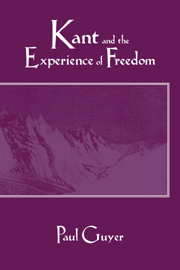Book contents
- Frontmatter
- Contents
- Preface
- Note on citations
- Introduction
- KANT'S AESTHETICS IN HISTORICAL CONTEXT
- Chapter 1 Feeling and freedom: Kant on aesthetics and morality
- Chapter 2 The dialectic of disinterestedness: I. Eighteenth-century aesthetics
- Chapter 3 The dialectic of disinterestedness: II. Kant and Schiller on interest in disinterestedness
- Chapter 4 The perfections of art: Mendelssohn, Moritz, and Kant
- Chapter 5 Hegel on Kant's aesthetics: necessity and contingency in beauty and art
- KANT'S AESTHETICS AND MORALITY: TOPICAL STUDIES
- Notes
- Bibliography
- Index
Chapter 5 - Hegel on Kant's aesthetics: necessity and contingency in beauty and art
Published online by Cambridge University Press: 05 March 2012
- Frontmatter
- Contents
- Preface
- Note on citations
- Introduction
- KANT'S AESTHETICS IN HISTORICAL CONTEXT
- Chapter 1 Feeling and freedom: Kant on aesthetics and morality
- Chapter 2 The dialectic of disinterestedness: I. Eighteenth-century aesthetics
- Chapter 3 The dialectic of disinterestedness: II. Kant and Schiller on interest in disinterestedness
- Chapter 4 The perfections of art: Mendelssohn, Moritz, and Kant
- Chapter 5 Hegel on Kant's aesthetics: necessity and contingency in beauty and art
- KANT'S AESTHETICS AND MORALITY: TOPICAL STUDIES
- Notes
- Bibliography
- Index
Summary
The differences between the aesthetic theories of Kant and Hegel are both less, and greater, than meet the eye. In Hegel's fullest account of his understanding of the place of art in absolute spirit, the posthumously published Lectures on Fine Art, it first looks as if Hegel has overstated the similarity between Kant's analysis of pure aesthetic judgments of beauty and his own conception of the theoretical significance of works of art; the interpenetration of concept and object which is central to Hegel's account of art and which he also claims to find in Kant's analysis of pure aesthetic judgment is not really there, although something which sounds similar – namely, harmony between our faculties of concepts and intuitions – is. However, when we turn from Kant's initial analysis of pure aesthetic judgments to his more developed theory, especially (but not only) of art, it may look as if Hegel may even have understated the similarity between his own account and Kant's. Kant's fully developed conception of art and aesthetic experience is not the exercise in formalism that might have been expected from his initial analysis of aesthetic judgment, but insists upon a deep connection between the experience of beauty, and sometimes the perceptible form of a work of art, and an idea of reason, in terms that sound very much like Hegel's own. There is one essential difference, however.
- Type
- Chapter
- Information
- Kant and the Experience of FreedomEssays on Aesthetics and Morality, pp. 161 - 184Publisher: Cambridge University PressPrint publication year: 1993
- 1
- Cited by

